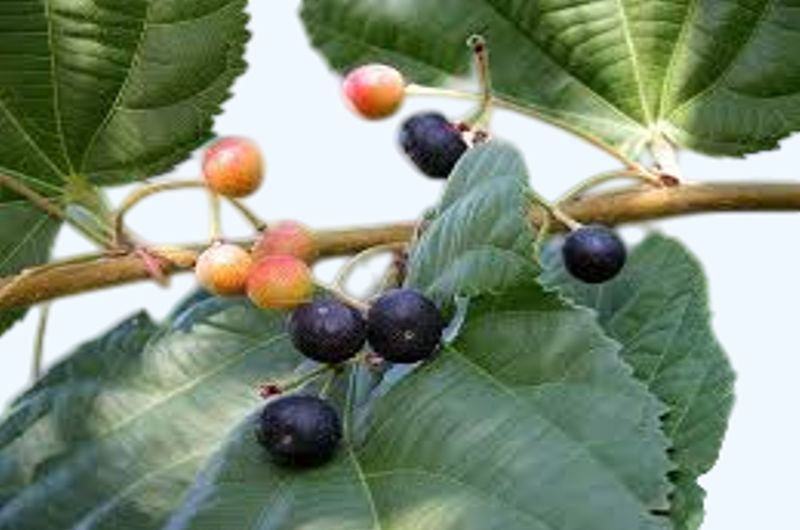Introduction:
A Powerful Yet Overlooked Berry Grewia asiatica, commonly known as Phalsa, is a small, deep-purple berry native to South Asia. Despite being overshadowed by more popular fruits, Phalsa boasts an impressive nutritional profile. Traditionally valued for its medicinal properties, modern science is now validating its wide-ranging health benefits, from boosting immunity to aiding digestion. This article explores Phalsa’s nutritional value, health advantages, and various ways to incorporate it into daily diets. 1. Nutritional Profile of Phalsa Though tiny, Phalsa is packed with essential nutrients: Key Nutrients per 100g: – Vitamin C (20-30 mg) – Strengthens immunity and enhances skin health – Iron (1.5 mg) – Helps prevent anemia – Calcium (130 mg) – Supports bone health – Potassium (372 mg) – Regulates blood pressure – Dietary fiber (5-6g) – Improves digestion – Antioxidants (anthocyanins, flavonoids) – Combat oxidative stress – Calories: Only 43 kcal per 100g, making it a low-calorie, nutrient-rich snack 2. Health Benefits of Phalsa 1. Strengthens Immunity – High vitamin C levels boost white blood cell production – Antimicrobial properties help protect against infections 2. Supports Digestive Health – Dietary fiber prevents constipation and promotes gut health – Traditionally used to treat diarrhea and dysentery due to its astringent nature 3. May Help Regulate Diabetes – Low glycemic index (GI) prevents sudden blood sugar spikes – Animal studies suggest it enhances insulin sensitivity 4. Benefits Heart Health – Potassium aids blood pressure regulation – Antioxidants help prevent LDL (“bad”) cholesterol oxidation 5. Acts as a Natural Cooling Agent – Used in Ayurvedic medicine to prevent heatstroke and dehydration – Phalsa sherbet (juice) is a popular summer refreshment in India and Pakistan 6. Provides Anti-Inflammatory & Pain-Relieving Effects – Studies show it reduces inflammation, particularly in arthritis models – Traditional medicine utilizes it for muscle soreness and joint pain 7. Enhances Skin & Hair Health – Vitamin C supports collagen production, promoting youthful skin – Antioxidants protect against UV damage – Oil extracts strengthen hair follicles 3. Traditional Uses in Ayurveda & Folk Medicine Phalsa has long been used for various therapeutic purposes: – Fever reducer – Helps lower body temperature – Liver tonic – Assists in detoxification – Respiratory remedy – Often found in cough syrups – Energy booster – Consumed by laborers to combat fatigue 4. Ways to Consume Phalsa for Maximum Benefits 1. Fresh Berries – Eaten raw (has a tart taste, similar to blackberries) – Sprinkled with black salt or chaat masala for extra flavor 2. Phalsa Juice or Sherbet – Blended with water, strained, and mixed with honey – Served chilled for hydration during hot weather 3. Jams & Desserts – Used in jellies, syrups, and ice creams 4. Dried Powder – Added to smoothies or yogurt for an extra nutrient boost 5. Potential Side Effects & Precautions While Phalsa is generally safe, there are some considerations: – Hard seeds – Excessive consumption may cause digestive discomfort – Blood sugar effects – Diabetics should monitor glucose levels – Pregnancy concerns – Limited research exists, so consult a doctor before use 6. Scientific Research & Future Potential Emerging studies indicate promising health benefits: – Anticancer properties – Some lab studies show Phalsa may inhibit tumor cells – Neuroprotective ef fects – Potential for supporting brain health – Wound-healing potential – Due to its antimicrobial properties While further human trials are needed, current findings highlight Phalsa’s immense potential in modern medicine. Conclusion: A Forgotten Superfruit Worth Embracing More than just a seasonal delicacy, Grewia asiatica (Phalsa) is a nutrient powerhouse with scientifically-backed health benefits. Whether eaten fresh, consumed as juice, or used in supplements, this versatile berry deserves recognition in modern diets. By incorporating Phalsa into daily nutrition, individuals can harness its wealth of benefits for overall wellness. Grewia Asiatica (Phalsa): A Nutrient-Dense Superfruit with Remarkable Health Benefits Introduction: A Powerful Yet Overlooked Berry The little, deep-purple berry Grewia asiatica, often called Phalsa, is indigenous to South Asia.Despite being overshadowed by more popular fruits, Phalsa boasts an impressive nutritional profile. Traditionally valued for its medicinal properties, modern science is now validating its wide-ranging health benefits, from boosting immunity to aiding digestion. This article explores Phalsa’s nutritional value, health advantages, and various ways to incorporate it into daily diets. 1. Nutritional Profile of Phalsa Though tiny, Phalsa is packed with essential nutrients: Key Nutrients per 100g: – Vitamin C (20-30 mg) – Strengthens immunity and enhances skin health – Iron (1.5 mg) – Helps prevent anemia – Calcium (130 mg): Promotes healthy bones – Potassium (372 mg) – Regulates blood pressure – Dietary fiber (5-6g) – Improves digestion – Antioxidants (anthocyanins, flavonoids) – Combat oxidative stress – Calories: Only 43 kcal per 100g, making it a low-calorie, nutrient-rich snack 2. Health Benefits of Phalsa 1. Strengthens Immunity – High vitamin C levels boost white blood cell production – Antimicrobial properties help protect against infections 2. Supports Digestive Health – Dietary fiber prevents constipation and promotes gut health – Because of its astringent properties, it has long been used to treat dysentery and diarrhea. 3. May Help Regulate Diabetes – Low glycemic index (GI) prevents sudden blood sugar spikes – Animal studies suggest it enhances insulin sensitivity 4. Benefits Heart Health – Potassium aids blood pressure regulation – Antioxidants aid in halting the oxidation of LDL (“bad”) cholesterol. 5. Acts as a Natural Cooling Agent – Used in Ayurvedic medicine to prevent heatstroke and dehydration – Phalsa sherbet (juice) is a popular summer refreshment in India and Pakistan 6. Provides Anti-Inflammatory & Pain-Relieving Effects – Studies show it reduces inflammation, particularly in arthritis models – Traditional medicine utilizes it for muscle soreness and joint pain 7. Enhances Skin & Hair Health – Vitamin C supports collagen production, promoting youthful skin – Antioxidants protect against UV damage – Oil extracts strengthen hair follicles 3. Traditional Uses in Ayurveda & Folk Medicine Phalsa has long been used for various therapeutic purposes: – Fever reducer: aids in bringing


